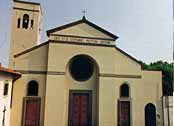Risen in 936 like the rural Parish Church of the castle in Campi, placed inside the walls and not outside as a rule. It still has the basilican plant with three aisles divided by seven rectangular pillars and the hut front, built in stone and limestone. It has lost the sternness of the Romanesque Parish Churches and for the many architectonic external and internal transformations, that already began in the thirteenth century. In 1774 the side aisles and the bell tower placed side by side the aisle on the right, that still has the forms of that period, were raised again. In 1813-1835 during the deepest restoration in neo-classical style, the Romanesque apse was sacrificed, the barrel vault that will hide the truss covering (not original) was built, and the stones were covered with stuccoes. The stations of the Cross and the new bells are placed, a new altar is built and the pipe organ is installed. In 1897 a following restoration tried to re-establish the ancient bond, the stuccoes are removed and, some partially restored canvas and frescoes, disfigured by the negligence and by the brought rearrangements and modifications are added. The front was rebuilt in 1938 by the architect Pietro Sanpaolesi, finishing the transformation that removes from the Parish Church every Romanesque references. In 1957 the glass windows adorned with figures were adjusted. The Parish Church marks the stages of the history and dominations of Campi and district, and, through the many restorations and rearrangements, the activity of the more powerful local families is testified. In particular in the buildings of the chapels the patronage on the castle of Campi is emphasized: in the sixteenth century the chapel of San Salvadore (under the bell tower) is built by the Rucellai family, in 1453 that one of the Annunziata completely rebuilt in the seventeenth century; in 1479 that one of San Bartolomeo by Del Troscia, in 1495 that one of San Clemente by Arrigo Mazzinghi, covered with cross vaults. Inside the aisle on the left: at the first pillar the marble stoup with the sculptured coat-of-arms of the De Troscia of 1478; at the first altar the Annunciation by Paolo Schiavo dated back to the fifteenth century; at the first chapel a marble baptismal font of 1897 of the school of Angelo Ferretti and a faithful copy of the robbiana statue of San Giovanni Battista; at the third chapel San Clemente, who communicates, oil painting of the end of the sixteenth century, the Annunciation, a seventeenth-century painting by Francesco Curradi, the guardian Angel and Sant'Antonio the abbot, a work of about 1650; at the fourth chapel (of Our Lady of Sorrows) a statue of paper-pulp of Santa Lucia and one of San Francesco. A marble balustrade and three steps lead to the major altar,a marble work of the half of the eighteenth century, realized by Vincenzo Foggini, and to a wooden Crucifix of the end of the seventeenth century. In the choir the dome was frescoed in the nineteenth century and it maintains choir stalls, pipe organ (of the eighteenth century rearranged by Michelangelo Paoli) and wooden stalls. In the aisle on the right at the first pillar the marble stoup of the Florentine school of the seventeenth century; in the second altar Jesus and San Giuseppe, a contemporary work by Giuseppe Masi of 1935; the altar-piece of the Virgin Mary with Child and Saints, recently restored, of the second half of the fifteenth century, then a scene of the Holy Sepulchre, the Crucifix of the Miracles, concealed by a cape, a wooden work to which miraculous powers are attributed; in the chapel a Santo Stefano of 1927 and a Crucifixion of the seventeenth century. In the parsonage: Jesus at the temple of 1639, two seventeenth-century works, a painting canvas of Santa Lucia and the flight into Egypt, a glazed majolica of robbiana school of the fifteenth century portrayed San Giovanni Battista, painting canvas that reproduced the adoration of the shepherds, the Virgin Mary, the adoration of the three Magi. From the square you can enter the parish theatre, an ancient oratory added to the church with decorated walls with pilaster strips of the first nineteenth century, in the frescoed chapel placed on the bottom of the Teathre, in correspondence with the Baptistery, the Annunciation and the Blessed Trinity fresco of the sixteenth-century of the school of Filippino Lippi attributed to Raffaellino del Garbo is placed. Lots of church ornaments and furnishings (pyxes, chalices, vestments), that cover all the period from the sixteenth century to the nineteenth century, with two bronze processional Crosses of the sixteenth century, a wrought iron branched candlestick of the Florentine school of the fourteenth century, a polychrome Crucifix. Always in the parsonage an important collection of "antiphonaries", ancient Gregorian codes of 1498-1503 and liturgical books with xylographies. Taken out from the text: Campi Bisenzio by Massimo Biagioni.
